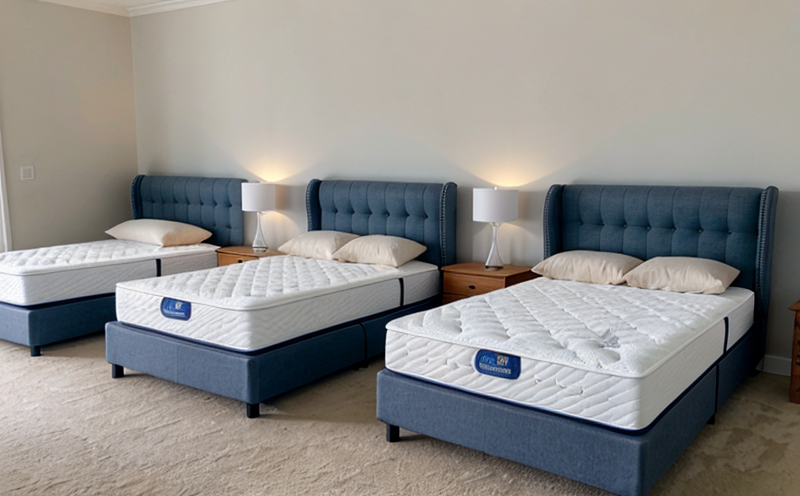DIN 4102 Fire Resistance Testing of Mattresses and Upholstered Beds
The DIN 4102 fire resistance test is a critical standard for ensuring the safety and compliance of mattresses and upholstered beds. This test evaluates the ability of mattress materials to resist ignition, flame spread, and maintain structural integrity under fire conditions. Quality managers and R&D engineers rely on this testing to ensure their products meet rigorous international standards.
The DIN 4102 standard is part of a series that addresses various aspects of fire safety in textiles used for furniture. It is widely recognized by quality assurance professionals, compliance officers, and R&D engineers within the furniture industry. The test is particularly important because it helps manufacturers ensure their products meet the stringent requirements set forth by regulatory bodies.
The testing process involves placing a specimen on a specially designed fire resistance apparatus that simulates real-world conditions. During the test, the specimen is subjected to an open flame for a specified duration and then evaluated based on several criteria including smoke production, heat release rate, and the ability of the material to self-extinguish.
The DIN 4102 standard has been in use since its inception, providing furniture manufacturers with a reliable method to assess the fire resistance properties of their products. This ensures that consumers are protected from potential hazards associated with flammable materials used in bedding and seating.
Compliance with this standard is mandatory for many countries, including Germany, Austria, and Switzerland, which have adopted it as part of their national regulations. Furniture manufacturers who fail to meet these requirements risk product recalls, legal action, and damage to their reputation.
The DIN 4102 test involves specific specimen preparation steps that include cutting the mattress or bed frame into a standard size for testing. The apparatus used in this process is designed to simulate the conditions under which the material might be exposed to fire. This includes factors such as heat, smoke, and flame spread.
The testing procedure typically consists of several stages, including pre-test preparation, ignition, observation, and post-test evaluation. During each stage, detailed measurements are taken using specialized instrumentation. These instruments help quantify key performance metrics that determine whether the specimen meets the required fire resistance standards.
The results of the DIN 4102 test provide valuable insights into the fire performance characteristics of mattress materials. By understanding these properties, manufacturers can make informed decisions about material selection and design improvements. This knowledge is crucial for developing safer products that meet both consumer expectations and regulatory requirements.
Applied Standards
| Standard | Description |
|---|---|
| DIN 4102-3:2020-06 | Fire resistance test for furniture textiles and components, Part 3: Mattresses and upholstered beds. |
| ISO 841 | Method of testing textile materials for flammability - Cone test. |
| ASTM E672-03(2015) | Standard test method for measurement of heat release rate, total smoke production, and mass loss rate using a cone calorimeter. |
Quality and Reliability Assurance
The reliability of the DIN 4102 test is ensured through strict adherence to international standards such as ISO, ASTM, and EN. These standards provide a framework for consistent testing procedures across different laboratories worldwide. By following these guidelines, testers can ensure that their results are accurate and repeatable.
Quality assurance in this context involves not only the technical aspects of conducting the test but also ensuring that all personnel involved are trained according to best practices. This includes regular calibration of equipment and participation in proficiency testing programs. The latter helps laboratories maintain their credibility by demonstrating consistent performance over time.
The reliability of the results is further enhanced by using advanced instrumentation capable of measuring multiple parameters simultaneously. For instance, systems that can measure heat release rate, total smoke production, and mass loss rate provide a comprehensive view of how well materials perform in fire scenarios. Such data allows for more precise comparisons between different samples or designs.
Moreover, continuous improvement efforts within the industry contribute to maintaining high standards. This includes ongoing research into new materials and technologies that could enhance fire safety while still being comfortable and aesthetically pleasing. Collaboration between academia, government agencies, and private enterprises fosters innovation in this area.
Competitive Advantage and Market Impact
- Ensures compliance with international standards.
- Promotes safer products, enhancing brand reputation.
- Facilitates easier access to markets where strict regulations apply.
- Supports continuous improvement through data-driven decision making.
The ability to demonstrate compliance with the DIN 4102 standard offers significant competitive advantages in today’s market. Consumers increasingly prioritize safety when purchasing furniture, especially for high-risk areas like bedrooms and sleeping quarters. By meeting these stringent requirements, manufacturers can differentiate themselves from competitors who may not adhere to such standards.
In addition to regulatory compliance, there are broader implications for businesses operating internationally. Many countries have adopted the DIN 4102 standard as part of their national regulations. This means that companies selling products in these markets need to ensure they meet this requirement if they want to avoid potential barriers at borders or during inspections.
The impact extends beyond just individual businesses; it also contributes positively towards public health and safety initiatives aimed at reducing fire-related incidents. By helping reduce the risk associated with flammable bedding materials, this testing plays a vital role in protecting consumers worldwide.





